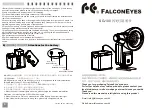
AT-200GE
- 13 -
6. Input and output circuits
This chapter introduces the basic diagram and bit allocation of digital output.
6.1. Iris video output
This signal can be used for lens iris control In
Continuous and RCT modes. The signal is NUM
luminance signal and passes through the gain
circuit. However, due to reversed
compensation applied, the gain settings do
not influence this signal. The iris video output
is 0.7 V p-p from 75
and without sync.
Fig. 9 Iris video output.
6.2. Trigger input
The trigger input is on pin #10 on the 12-pin
connector or pin#3 on the D-sub 9-pin
connector. The input is AC coupled. To allow
a long pulse width, the input circuit is a flip-
flop, which is toggled by the negative or
positive differentiated spikes caused by the
falling or rising trigger edges.
The trigger polarity can be changed.
Trigger input level is 4 V
2 V. It can be
terminated by SW600: ON for 75
. OFF for
TTL(Factory default).
Fig.10 Trigger input.
6.3. XEEN output
XEEN is found on pin #4 or #8 on D-sub 9-pin
connector.
The output circuit is 75
complementary
emitter followers. Output level
3 V from 75
.
(No termination).
When the open collector is used, the maximum
current is 120mA. However, if a current of more
than 50mA is flowed, it is necessary to use
bigger diameter wires for connecting pin#8 and
9. In case of narrower wires, due to its
resistance, it may not work properly.
This output can be changed to Open collector
signal by SW100.
EEN is found in OPT out in 12-pin connector.
Fig.11 EEN output
DAC
Iris Video
2K2
1K
1μ
0.1
μ
+5V
+5V
●
●
●
●
●
SW600
TTL
1K
100K
0.001μ
0.1μ
1K2
15K
39K
75
HIROSE 12P
#10
+
5V
1K
0.1
10K
10
10
220
EEN
HIROSE
#9
120
150
Open
Collector
Push
Pull
10K
1K
180
SW100
















































